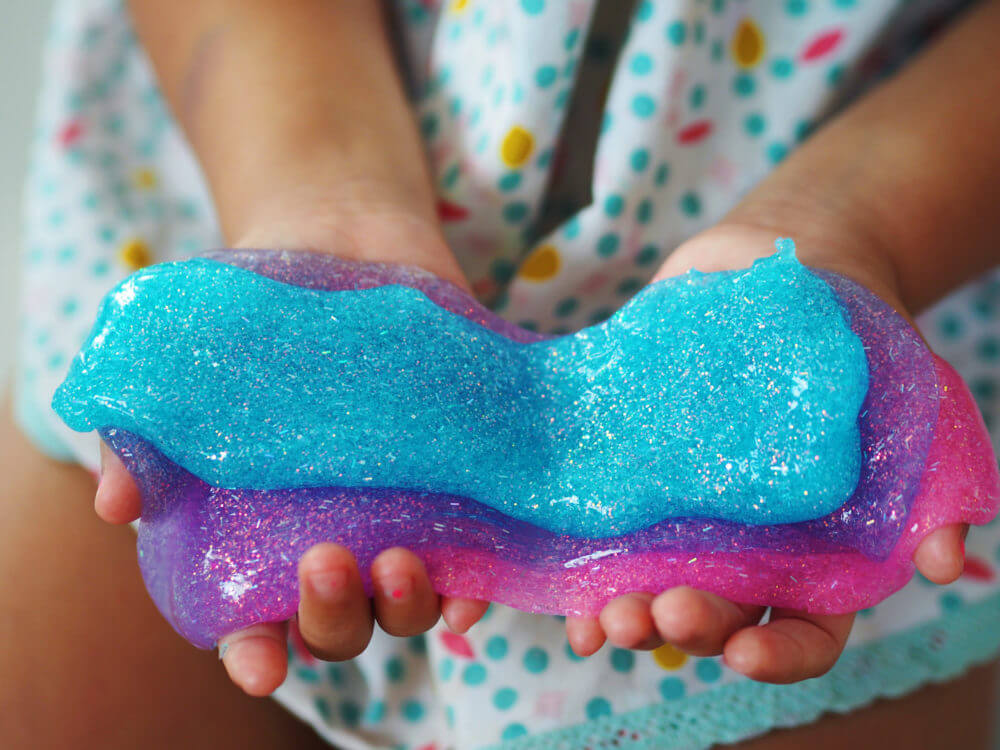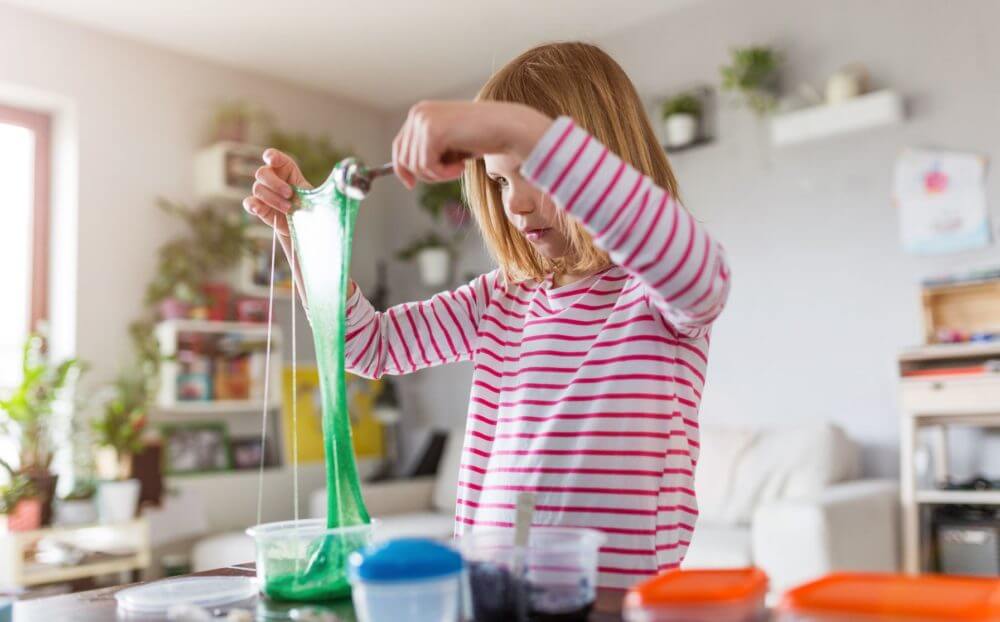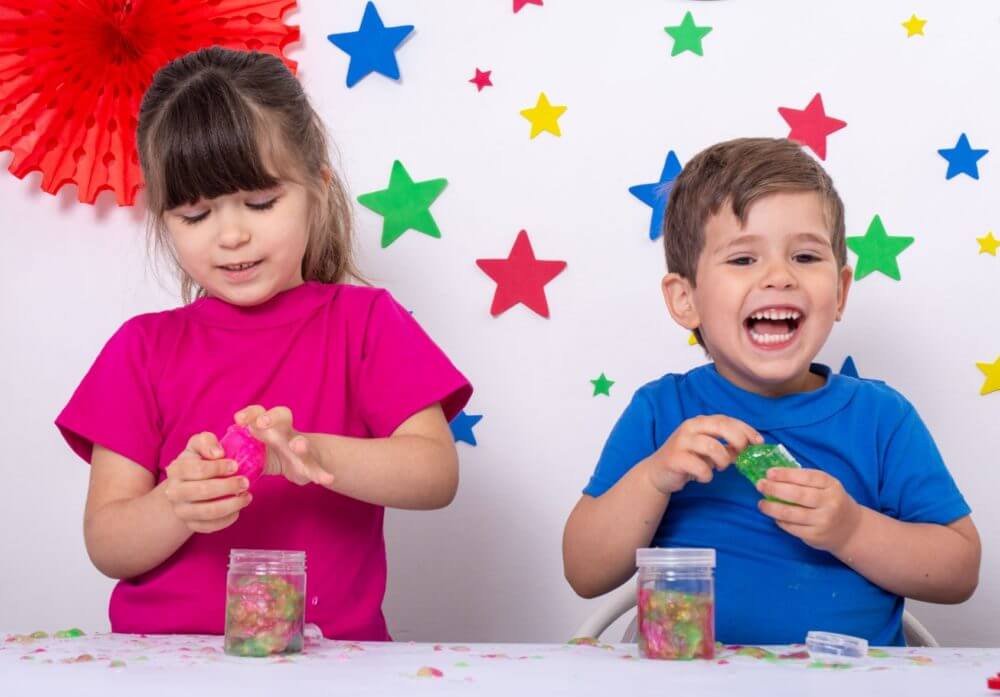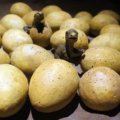Slime is a wonderful sensory substance to play with. It encourages tactile stimulation, mindfulness, and focus as well as being comforting.
Contents
The process of making slime can make the whole experience doubly fun. It’s a hands-on, safe, chemical experiment you can do at home. If you want ways to engage your little ones in STEM activities, making slime is perfect.
Usually, slime uses borax or laundry starch as a thickening agent. Borax and laundry starch work by pulling the liquid elements of the slime together. It’s sort of like what flour does to dough.

The issue with borax or laundry starch is that they can both cause skin reactions. This is particularly common amongst people with sensitive skin.
Have no fear, though. It’s possible to make slime with baking soda. This kind of slime is much kinder to sensitive skin.
The Science of Slime
Slime is usually made with borax or ingredients that contain borax such as contact lens solution and laundry starch.
PVA glue is the other main ingredient. PVA glue has long chains of polymers. These polymer chains are long collections of molecules. The chains slip and slide over each other easily which is why glue can pour fairly easily.
The borax and the polymers interact with each other and change the molecular layout of the polymers. This is called cross-linking.
When molecules are cross-linked they become a bit more tangled. This is why slime can stretch and flow.
If you pull sharply or overstretch the slime it does break off. This is because the molecular connections aren’t very strong.
When you remove borax from the equation and use baking soda, you aren’t making cross-linked molecules. What happens is the baking soda encourages the glue to set making it sticker and firmer.
The addition of water allows the slime to stay slimy. It sort of holds the glue in limbo. It’s not set firm but it’s not liquid either.
Want to try it yourself? Read on for the recipe.
What Do You Need?
- Clear glue (something like Elmer’s)
- Food coloring
- Baking soda
- Glitter (optional)
- Warm water
How to Make Slime
Step 1: Prepare the baking soda
Mix ½ cup of baking soda with 2 cups of water.
Make sure you give it a good old mix.
Step 2: Color the glue
Put about 5oz of glue into another bowl and add food coloring of your choice. Add it drop by drop until you get the vibrancy you want.
If you want to add glitter, do it now and give the whole mixture a good stir. You want to make all of the glue colored otherwise you’ll have patchy slime.
Step 3: Mix the two containers
Pour the glue mixture into the baking soda and water.
You’ll notice that the glue mixture begins to form balls in the water as it picks up particles of baking soda.
To get your slime, just fish out these balls and bring them together in your hands. This is a wet slime so don’t worry if it’s not what you’re used to.
Considerations
You’ll notice as you play that this is quite a wet, sticky slime. If you don’t want it to stick to your fingers, you can dip your hands in the baking soda mixture. You’ll need to do this every so often to stop it from sticking.
If the goo becomes too loose and wet you can drop it back to the baking soda. This will make it a bit more firm. You can do this time and time again. At some point, you’ll probably want to mix more baking soda into the water.
This gooey slime is more appropriate for messy play or as a writing tray substance. It makes wonderful squelchy sounds and has a great sticky feel. It’s a really great sensory experience!
You don’t want to use this slime near carpets or fabrics as it can get a bit sticky. You might also want to put an apron on your little one as they play. This slime will wash out of clothes in a standard wash.
If you find the slime in hair, you’ll be able to get it out with shampoo and conditioner. A quick comb through after will take care of any leftover bits.
The good thing about baking soda is that it’s non-toxic. If your kid likes to learn with their mouth it won’t harm them. They won’t enjoy the experience but it won’t do them damage.
Final Thoughts
There are lots of different ways to make slime. This recipe is good for people with sensitive skin but produces a squishier slime.
You can play about with the quantities of the ingredients to get different textures. Make it a fun experiment by changing things up.
As a parent of a five-year-old inquisitive boy, I have gained a lot of experience finding fun activities and toys to help him understand science and understanding our world in general. On this blog, you’ll find an extensive amount of tutorials, guides, and toys about Science, Technology, Engineering, and Math based on my personal experience to help your child develop critical STEM skills.






